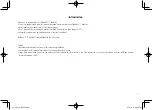
130
Positioning
GPS data
Select
Menu
>
Applications
>
GPS
>
GPS data
.
GPS data is designed to provide route guidance information to a selected destination,
position information about your current location, and travelling information, such as
the approximate distance to the destination and the approximate duration of travel.
The coordinates in the GPS are expressed in degrees and decimal degrees format
using the international WGS-84 coordinate system.
To use GPS data, the GPS receiver of your device must initially receive position
information from at least four satellites to calculate the coordinates of your location.
When the initial calculation has been made, it may be possible to continue calculating
the coordinates of your location with three satellites. However, the accuracy is
generally better when more satellites are found.
Route guidance
Select
Menu
>
Applications
>
GPS
>
GPS data
>
Navigation
.
Start the route guidance outdoors. If started indoors, the GPS receiver may not
receive the necessary information from the satellites.
Route guidance uses a rotating compass on the device display. A red ball shows the
direction to the destination, and the approximate distance to it is shown inside the
compass ring.
Route guidance is designed to show the straightest route and the shortest distance
to the destination, measured in a straight line. Any obstacles on the route, such as
buildings and natural obstacles, are ignored. Differences in altitude are not taken into
account when calculating the distance. Route guidance is active only when you
move.
To set your trip destination, select
Options
>
Set destination
and a landmark as the
destination, or enter the latitude and longitude coordinates.
To clear the destination set for your trip, select
Stop navigation
.
Retrieve position information
Select
Menu
>
Applications
>
GPS
>
GPS data
>
Position
.
In the position view, you can view the position information of your current location. An
estimate of the accuracy of the location is displayed.
To save your current location as a landmark, select
Options
>
Save position
.
Landmarks are saved locations with more information, and they can be used in other
compatible applications and transferred between compatible devices.
Trip meter
Select
Menu
>
Applications
>
GPS
>
GPS data
>
Trip distance
.
The trip meter has limited accuracy, and rounding errors may occur. Accuracy can
also be affected by availability and quality of GPS signals. To turn trip distance
calculation on or off, select
Options
>
Start
or
Stop
. The calculated values remain
on the display.
Use this feature outdoors to receive a better GPS signal.
To set the trip distance and time and average and maximum speeds to zero, and to
start a new calculation, select
Options
>
Reset
. To set the trip meter and total time
to zero, select
Restart
.
Positioning settings
Select
Menu
>
Ctrl. Panel
>
Settings
>
General
>
Positioning
.
To use a specific positioning method to detect the location of your device, select
Positioning methods
Select from the following:
•
Integrated GPS
— Use the integrated GPS receiver of your device.
•
Assisted GPS
— Use Assisted GPS (A-GPS) to receive assistance data from an
assistance data server.
•
Bluetooth GPS
— Use a compatible external GPS receiver with Bluetooth
connectivity.
•
Network based
— Use information from the cellular network (network service).
















































